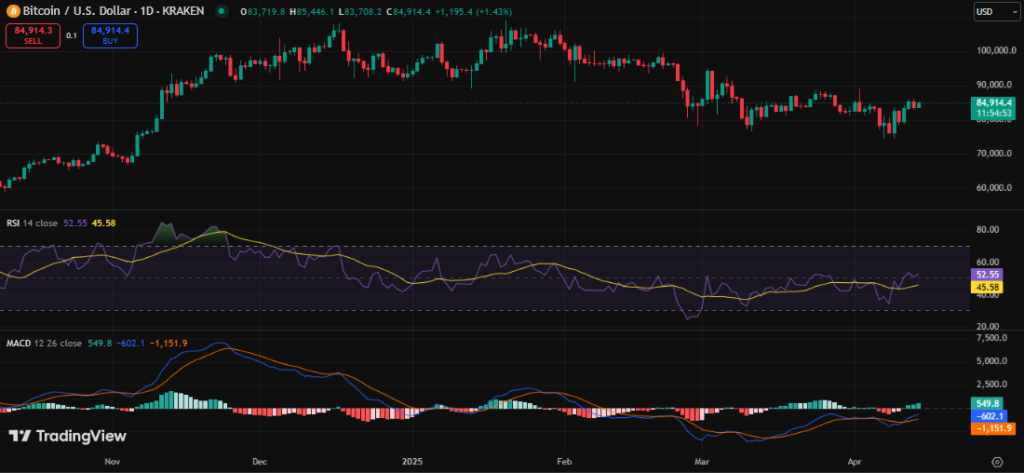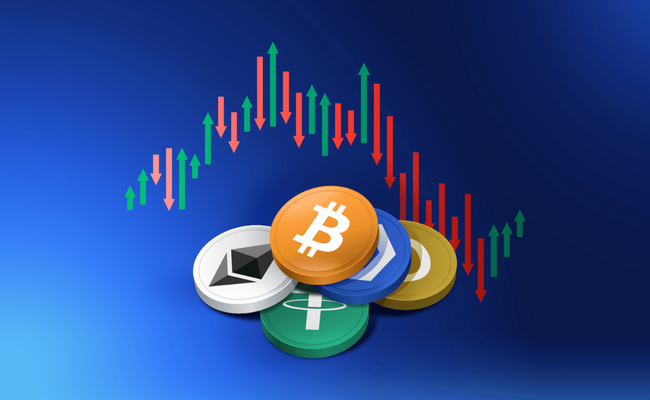The crypto market experienced drastic fluctuations last week, and the announcement of the new tariffs under President Donald Trump’s “Liberation Day” plan influenced the market movements. The executive order was a 10% tariff on all products, which became higher for countries with significant trade deficits with the U.S., raising the concern of a global recession.
However, Trump decided to pause the tariffs for all the countries except China. This led to a brief broad market recovery following the uncertainty. Amidst these shifts, several key developments occurred across the week, such as the U.S. disbanding the crypto enforcement unit, Paul Atkins being confirmed as the SEC Chairman, and many more.
In the section below, we will discuss the crypto weekly market wrap in detail. Ensure you read to the end to gain a thorough understanding of what happened throughout the week.
The US Announces a Temporary Reduction of Tariffs
President Donald Trump made an announcement on April 10th regarding the lessening of tariffs to countries other than China. Trump noted that more than 75 nations had reached out to the US in matters such as trade, tariffs, and manipulation of exchange rates. These countries did not take any action against the U.S. as they considered the move from the U.S. government.
The U.S. government opted to adopt a 90-day suspension measure for these countries. In this period, the reciprocal tariff was lowered to 10%, with immediate implementation. However, the tariff imposed on China was increased to 125%.
This temporary change in tariff led to high uncertainty in the market. After the announcement, there was a short-term bounce back in global markets. This decision to suspend tariffs for most countries was widely considered as a move to start unwinding fears of the global economy. However, the improved tariff to China remained an issue fuelling tensions.
Paul Atkins Confirmed as the Chairman of the US SEC
The US Senate approved Paul Atkins as the new Chairman of the SEC. The vote ended with 52 in support and 44 against. President Donald Trump nominated Atkins, who had once worked as an SEC commissioner under George W. Bush’s presidency. Bush. He will succeed Mark Uyeda, who has been serving as the acting chair.
Confirmed, 52-44: Confirmation of Executive Calendar #61 Paul Atkins to be a Member of the Securities and Exchange Commission for the remainder of the term expiring June 5, 2026.
— Senate Cloakroom (@SenateCloakroom) April 9, 2025
His confirmation has been hailed as a big win in the SEC’s take on the issue of cryptocurrencies and digital assets. In his hearings for the confirmation, Atkins was particularly insistent on having proper rules governing digital assets. He also promised to combine innovation and stability to achieve his goal of improving the market.
This was unlike his predecessor, Gary Gensler, who was said to be inclined to be negative toward the crypto industry. Atkins’ pro-crypto sentiment would mean bringing more light to regulation, clear guidelines and a positive shift in the US’ approach towards digital currencies.
Hong Kong Securities and Futures Commission Allows Staking for Licensed Platforms
The Hong Kong Securities and Futures Commission (SFC) issued a statement that authorizes virtual asset trading license holders to provide staking services. The SFC affirms that the licensed platform can offer staking services but needs to put in place adequate measures to minimize the risk. Such measures include safeguarding customer funds and providing them with clear information on the risks inherent in staking.
The Hong Kong SFC officially released stake-related guidelines. For licensed virtual asset trading platforms: they are allowed to provide staking services, but they must take measures to reduce risks, protect customer assets, and fully disclose stake risks.…
— Wu Blockchain (@WuBlockchain) April 7, 2025
The SFC allows virtual asset funds to stake digital assets. However, they can only do so through trading platforms or other institutions licensed by the authority. The funds must also adhere to certain restrictions regarding the management of liquidity risks. Many consider this new regulation a positive move that aims to expand institutional participation in the crypto space. Through developing clearer rules of conduct in the market, the SFC endeavors to enhance the level of trust that, in turn, may attract more people to invest.
Ukraine Proposes an 18% Income Tax on Virtual Asset Earnings
Ukraine is planning to introduce tax reform through an 18% income tax on the income resulting from virtual assets. The proposal, currently under the National Securities and Stock Market Commission of Ukraine (NSSMC), includes a 5% military surtax on profits generated in cryptocurrencies. This proposal pertains to various incomes like rewards obtained from mining, staking, and airdrops.
However, the proposal introduces graduated taxes on earnings from cryptocurrency transactions from 5% to 9% for certain categories of earners. The tax will not be levied on the exchange of crypto-assets so the individuals engaging in trading will not have to pay any tax. The proposal has been presented to the Ukrainian parliament to debate. It is anticipated that it will attract alterations as the government gauges the industry.
Ripple Pushes Forward with $1.25B Acquisition
Ripple is making great efforts in terms of combining traditional finance with decentralized finance. The firm recently acquired prime broker Hidden Road for $1.25 billion. Hidden Road clears approximately $3 trillion annually and caters to over 300 institutions. This marks a significant milestone for Ripple as it tries to expand its institutional base and get closer to traditional finance.
Today, Ripple announced it is acquiring Hidden Road for $1.25B– becoming the first crypto company to own and operate a global, multi-asset prime broker. Together, Ripple and Hidden Road are bringing the promise of digital assets to institutional customers at scale, bridging…
— Ripple (@Ripple) April 8, 2025
According to the deal, RLUSD will integrate into Hidden Road’s collateral ecosystem. This will also shift post-trade operations to include XRP Ledger, which will enhance transparency and operational efficiency. Ripple CEO Brad Garlinghouse described the deal as a major milestone, marking a turning point in digital asset adoption and setting the stage for future growth.
Teucrium Launches XRP ETF
Teucrium introduced an XRP-based ETF on the NYSE Arca market. The product involves the 2x Daily XRP ETF, which seeks to track twice the daily price fluctuations of XRP. This product leverages derivatives instead of holding the XRP directly and is thus more suitable for active traders who are willing to take more risks for higher returns.
This ETF suggests that institutional interest in cryptocurrencies is shifting beyond Bitcoin and Ethereum. Although the product has a higher risk level because of leverage, this is viewed as a positive sign of segmented institutional entry into the digital asset market. If approved, a spot ETF would be a less risky mechanism through which retail and long-term investors can invest in XRP.
SEC Approves Options Trading on Ethereum Spot ETFs
The U.S. Securities and Exchange Commission approved options on several Ethereum spot exchange-traded funds. They include BlackRock’s iShares Ethereum Trust and Grayscale’s Ethereum Trust, among others. These ETFs enable investors to major in Ethereum without the need to own it.
With the approval of options trading, Ethereum ETFs will now have similar trading prospects as Bitcoin ETFs. Hedging can be achieved through the use of options and exchanges such as Nasdaq will be able to sell and list options on Ethereum ETFs. This helps to increase the possibility of trading for both institutional and retail clients. This also contributes to the growth of the Ethereum market, increasing capital investments and paving the way to new opportunities for trading.
Trader Took Loss of $10M on Selling a Single CryptoPunk NFT
In the world of NFTs, an anonymous trader recorded a major loss when they sold a rare CryptoPunk NFT for 4,000 ETH, valued at approximately $6.07 million. The initial purchase of this NFT was 4,500 ETH, which was equivalent to $15.79 million at the time. The trader attributed the loss of nearly $10 million to the decline in the value of ETH over the past year.
NFT TRADER DOWN $10M ON CRYPTOPUNK
This NFT Trader bought an Alien Cryptopunk 1 year ago for 4.5K ETH ($16M). He just sold it for 4K ETH ($6M).
He just locked in a $10M loss.
Address: 0x70587661c804c72BBa25EcddD8d17B332C984017 pic.twitter.com/765PHvUzob
— Arkham (@arkham) April 10, 2025
CryptoPunk 3100 is one of only nine Alien Punks among the original 10,000 CryptoPunks released by Larva Labs in 2017. However, CryptoPunks is one of the most popular collections despite its value declining by nearly 43% in the past three months.
World Liberty Financial Holders Could Get USD1 Airdrop
World Liberty Financial, backed by Trump, proposed issuing a test airdrop of its USD 1 pegged stablecoin to those who hold the WLFI token. The team will conduct this test to check the stability of the airdrop system and reward those who supported the platform’s development earlier. If approved, the team will perform the test on the Ethereum Mainnet.
According to the proposal outlined, the amount of USD1 stablecoins to be distributed per recipient will be determined by the number of wallets of participants and the overall budget. This will offer public awareness of the USD1 stablecoin in the industry before its general release to the public. World Liberty Financial has also opened a community poll for voters regarding the final airdrop details. The decision on whether the proposal will be implemented requires a governance vote.
Donald Trump Signs Resolution to End IRS DeFi Broker Rule
President Trump signed a resolution to repeal an IRS regulation that would have forced DeFi platforms to report users’ crypto sales. The regulation, issued near the end of Biden’s term, broadened the definition of ‘broker’ encompassing such non-custodial companies as decentralized finance applications.
🚨 HISTORY MADE 🚨
Just now, @POTUS signed my bill to repeal to the IRS DeFi Crypto Broker Rule.
This is the first cryptocurrency bill EVER signed into law by a president.@HouseGOP is working to keep America as the crypto capital of the world!
— Congressman Mike Carey (@RepMikeCarey) April 10, 2025
The cancellation of this rule becomes a victory for the DeFi sector. It solves a large compliance headache for DeFi platforms that are based on decentralized systems and do not control users’ identification information. In addition, many consider the change a positive shift in crypto regulation in the US, allowing DeFi platforms to function without excessive control.
Crypto Market Overview
In the latest report released by Coinshares, digital asset investment products witnessed a net outflow of $795 million last week. This was the third consecutive week of decline, bringing the total sell-offs since the start of February to $7.2bn. This has produced a negative sentiment that has erased almost all year-to-date inflows, currently standing at $165m.
The decline accompanies recent trade tariffs anxiety, which significantly affected the market. A price rebound towards the end of the week boosted the assets under management (AuM) to $130 billion, an 8% increase.
📉 Persistent negative sentiment with further outflows of US$795m…Our fund flows are live!
Third consecutive week of declines with @Bitcoin leading the outflows at US$751m, followed by @ethereum with the second largest outflows of the week at US$37.6. Certains altcoins are… pic.twitter.com/pdOUkd6SJQ
— CoinShares (@CoinSharesCo) April 14, 2025
Bitcoin had the highest outflows, with a value of $751 million. Despite this, Bitcoin still holds $545 million in YTD inflows. This suggests that sentiment within the market depends on global macroeconomic factors. The global and diversified redemptions signal negative sentiments about the asset class from many countries and providers. Furthermore, short-bitcoin products had net outflows of $4.6m, the same as Bitcoin in this case.
Ethereum recorded a net outflow of $37.6 million. Other significant tokens and coins, including Solana, Aave, and Sui, also experienced dips throughout the week. In Solana, $5.1 million was lost, while Aave had $0.78 million, and Sui also suffered a $0.58 million outflow. Such declines indicate that the expansion of the digital asset market may encounter more selling pressure as leading cryptocurrencies are experiencing a difficult phase.
On a more positive note, select altcoins bucked the trend. XRP led inflows with $3.5 million, followed by Ondo, Algorand, and Avalanche, which saw modest inflows of $0.46 million, $0.25 million, and $0.25 million, respectively. These smaller altcoins showed resilience in an otherwise challenging market environment. XRP stood out as a strong performer amid the broader downturn.
Bitcoin Price Performance
The leading asset, Bitcoin, closed the week above the $80K mark after the sharp drop to the $75K region. BTC was able to climb above the $85K region and faced stiff resistance at the $86K region, leading to a minor pullback. Despite the volatility, BTC surged by 10% onthe weekly chart. Currently, the price has consolidated around the $84K levels, with the bulls hinting at an imminent further uptrend.
Looking at the technical indicators, BTC has shifted the bearish trend as the green candlesticks rule the chart. Indicators such as the Relative Strength Index (RSI) and Moving Average Convergence Divergence (MACD), have turned positive following the recent continous downtrend. The MACD line has climbed back above the signal line indicating that the bulls are back in action.

Furthermore, the RSI has retraced the neutral levels from the oversold region. This positive momentum suggests that the selling pressure has eased as the buyers take control. Should the positive momentum hold, BTC could head to break the immediate resistance at the $86K region and push for the $90K mark.
Best Crypto Exchange
- Over 90 top cryptos to trade
- Regulated by top-tier entities
- User-friendly trading app
- 30+ million users
eToro is a multi-asset investment platform. The value of your investments may go up or down. Your capital is at risk. Don’t invest unless you’re prepared to lose all the money you invest. This is a high-risk investment, and you should not expect to be protected if something goes wrong.






